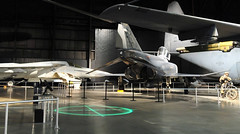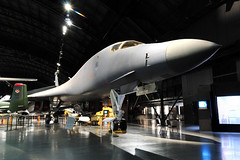 Fairchild Republic A-10A Thunderbolt II: The A-10 Thunderbolt II is an American single-seat, twin-engine, straight-wing jet aircraft developed by Fairchild-Republic for the United States Air Force to provide close air support (CAS) of ground forces by attacking tanks, armored vehicles, and other ground targets with a limited air interdiction capability. It is the first U.S. Air Force aircraft designed exclusively for close air support. The A-10's official name comes from the Republic P-47 Thunderbolt of World War II, a fighter that was particularly effective at close air support. The A-10 is more commonly known by its nickname "Warthog" or simply "Hog". As a secondary mission, it provides airborne forward air control, guiding other aircraft against ground targets. A-10s used primarily in this role are designated OA-10. The A-10 is expected to be replaced by the F-35 in 2028 or later.
Fairchild Republic A-10A Thunderbolt II: The A-10 Thunderbolt II is an American single-seat, twin-engine, straight-wing jet aircraft developed by Fairchild-Republic for the United States Air Force to provide close air support (CAS) of ground forces by attacking tanks, armored vehicles, and other ground targets with a limited air interdiction capability. It is the first U.S. Air Force aircraft designed exclusively for close air support. The A-10's official name comes from the Republic P-47 Thunderbolt of World War II, a fighter that was particularly effective at close air support. The A-10 is more commonly known by its nickname "Warthog" or simply "Hog". As a secondary mission, it provides airborne forward air control, guiding other aircraft against ground targets. A-10s used primarily in this role are designated OA-10. The A-10 is expected to be replaced by the F-35 in 2028 or later. Panavia Tornado GR1: The Panavia Tornado is a family of twin-engine combat aircraft, which was jointly developed by the United Kingdom, West Germany and Italy. There are three primary versions of the Tornado; the Tornado IDS (Interdictor/Strike) fighter-bomber, the suppression of enemy air defences Tornado ECR (Electronic Combat/ Reconnaissance) and the Tornado ADV (Air Defence Variant) interceptor. In 2008 Air Forces Monthly labelled the aircraft "for more than a quarter of a century... the most important military aircraft in Western Europe."
Panavia Tornado GR1: The Panavia Tornado is a family of twin-engine combat aircraft, which was jointly developed by the United Kingdom, West Germany and Italy. There are three primary versions of the Tornado; the Tornado IDS (Interdictor/Strike) fighter-bomber, the suppression of enemy air defences Tornado ECR (Electronic Combat/ Reconnaissance) and the Tornado ADV (Air Defence Variant) interceptor. In 2008 Air Forces Monthly labelled the aircraft "for more than a quarter of a century... the most important military aircraft in Western Europe."Also visible in the picture are the Cessna T-41A Mescalero, the Cessna T-37B Tweet (both hanging from the ceiling), and the big back of the Douglas C-133A Cargo Master.
 Lockheed F-117A Nighthawk (see also dedicated blog post) in front of a Lockheed AC-130A Spectre, a heavily-armed ground-attack aircraft ("gunship"), converted from the C-130 Hercules military transport aircraft. The gunship on display, named Azrael (Azrael, in the Koran, is the angel of death) this aircraft figured prominently in the closing hours of Operation Desert Storm. On 26 February 1991, Coalition ground forces were driving the Iraqi Army out of Kuwait. With an Air Force Reserve crew called to active duty, Azrael was sent to the Al Jahra highway between Kuwait City and Basra, Iraq, to intercept the convoys of tanks, trucks, buses, and cars fleeing the battle. Facing SA-6 and SA-8 surface-to-air missiles and 37 mm and 57 mm radar-guided anti-aircraft artillery the crew attacked and destroyed or disabled most of the convoys.
Lockheed F-117A Nighthawk (see also dedicated blog post) in front of a Lockheed AC-130A Spectre, a heavily-armed ground-attack aircraft ("gunship"), converted from the C-130 Hercules military transport aircraft. The gunship on display, named Azrael (Azrael, in the Koran, is the angel of death) this aircraft figured prominently in the closing hours of Operation Desert Storm. On 26 February 1991, Coalition ground forces were driving the Iraqi Army out of Kuwait. With an Air Force Reserve crew called to active duty, Azrael was sent to the Al Jahra highway between Kuwait City and Basra, Iraq, to intercept the convoys of tanks, trucks, buses, and cars fleeing the battle. Facing SA-6 and SA-8 surface-to-air missiles and 37 mm and 57 mm radar-guided anti-aircraft artillery the crew attacked and destroyed or disabled most of the convoys. McDonnell Douglas RF-4C Phantom II (on the right): a tandem two-seat, twin-engined, all-weather, long-range supersonic jet interceptor fighter/fighter-bomber originally developed for the U.S. Navy; Phantom production ran from 1958 to 1981, with a total of 5,195 built, making it the second most-produced Western jet fighter behind the F-86 Sabre.
McDonnell Douglas RF-4C Phantom II (on the right): a tandem two-seat, twin-engined, all-weather, long-range supersonic jet interceptor fighter/fighter-bomber originally developed for the U.S. Navy; Phantom production ran from 1958 to 1981, with a total of 5,195 built, making it the second most-produced Western jet fighter behind the F-86 Sabre.General Dynamics EF-111A Raven (on the left): an electronic warfare aircraft designed to replace the obsolete Douglas EB-66 in the United States Air Force. Its crews and maintainers often called it the "Spark-Vark," a play on the F-111's "Aardvark" nickname.
 Sikorsky MH-53M Pave Low IV: a long-range combat search and rescue (CSAR) helicopter; the helicopter on display carried the command element during Operation Ivory Coast, the mission to rescue American prisoners of war from the Son Tay North Vietnamese prison camp in 1970. See also dedicated blog post.
Sikorsky MH-53M Pave Low IV: a long-range combat search and rescue (CSAR) helicopter; the helicopter on display carried the command element during Operation Ivory Coast, the mission to rescue American prisoners of war from the Son Tay North Vietnamese prison camp in 1970. See also dedicated blog post.
Boeing B-1B Lancer: envisioned in the 1960s as a supersonic bomber with sufficient range and payload to replace the B-52 Stratofortress, it developed primarily into a low-level penetrator with long range and supersonic speed capability. Its development was stopped and restarted multiple times over its history, as the theory of strategic balance changed from flexible response to mutually assured destruction and back again. It eventually entered service more than 20 years after first being studied.See also dedicated blog post.

No comments:
Post a Comment